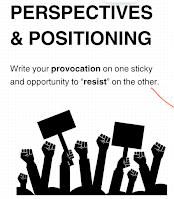Today's RPI session covered 'Thinking' - more specifically Critical thinking and how we can expose, model and extract this from our learners in our classes.
Dorothy Burt started us off strong with an overview and reminder of our Cybersmart features available to all to ensure our students are being smart citizens online.
Next Naomi covered an integral part of why and how we cover reading in our session about higher order thinking.
Helping Students Think Deeply About What They Read
Good reading lessons aren’t just about reading the words — they’re about helping students think. The Effective Literacy Strategies remind us to plan for different levels of thinking: literal (what the text says), interpretative (what the text means), and evaluative (what we think about it). The deeper thinking happens when we go “above the line” — this is called higher order thinking. At this level, students are not just understanding a text, they’re analysing, evaluating, and even creating new ideas. Tools like Bloom’s Taxonomy and Solo Taxonomy help us plan these kinds of lessons, where students think more deeply and make stronger connections.
To help students understand this kind of thinking, it can help to use simple examples. We might say that learners start out like magpies — gathering interesting words and ideas from texts. But when they begin to think more deeply, they become like hawks — flying high, looking closely, and noticing things others might miss. This kind of thinking helps students realise that language has power. Authors make choices to guide how we think or feel, and readers can notice and question that. When we plan lessons that include these kinds of thinking, we help our students become smarter readers and better thinkers.
I thoroughly enjoyed our session on Perspectives and Positioning.
Kiri's session about using provocations helps students become deeper thinkers. Instead of asking easy questions, a provocation makes a strong statement that not everyone will agree with. This gets students talking, thinking, and sharing different opinions. It encourages them to explain their ideas and look more closely at what a text is really saying. This is part of building critical literacy — helping students see that language has power, and that authors can influence how we think. When we use provocations, we help students go beyond surface-level understanding and think about whose voices are being heard and what messages are being shared.
Part of our homework was to bring a text - My chosen text was Bok Choy - Paul Mason. As part of our perspectives and positioning activity we shared on Canva a provocation from our text, as well as an opportunities for students to respond - called 'create to resist' - this encouraged us to think what opportunities will learners have to make different choices as authors or creaters. Below is what I came up with for my chosen text.




Kia ora Latini
ReplyDeleteThank you for your insightful reflections from day 7 of the RPI. I particularly identified with the concept you picked up on where we teach our children to become magpies initially and then, as they develop stronger inference skills we need to teach them to become hawks, flying high and noticing the information and messages in texts that others may miss.
Perspectives and positioning are important for our students to understand as they become better at critical thinking. I look forward to hearing if you have been successful in introducing provocation into your teaching as a means of helping your students to take on different perspectives and understand how texts may position us as readers.
It appears your planning is well developed for capturing critical literacy learning opportunities over the next few weeks. I hope both you and your class enjoy the learning journey.
Ngā mihi nui
Janet